splunk LB和scale(根本在于分布式扩展index,search)
Forwarder deployment topologies
You can deploy forwarders in a wide variety of scenarios. This topic provides an overview of some of the most useful topologies that you can create with forwarders. For detailed information on how to configure various deployment topologies, see Consolidate data from multiple hosts.
Data consolidation
Data consolidation is one of the most common topologies, with multiple forwarders sending data to a single Splunk instance. The scenario typically involves universal forwarders forwarding unparsed data from workstations or production servers to a central Splunk Enterprise instance for consolidation and indexing. In other scenarios, heavy forwarders can send parsed data to a central Splunk indexer.
Here, three universal forwarders are sending data to a single indexer:
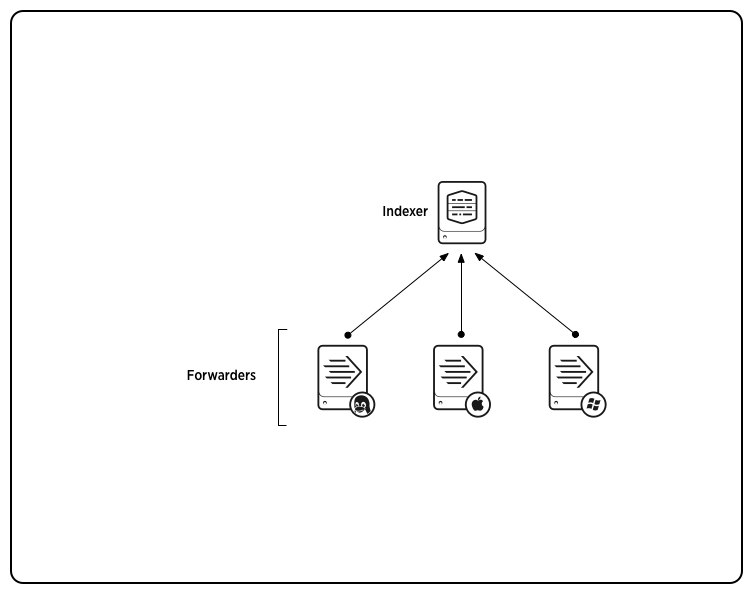
Load balancing
Load balancing simplifies the process of distributing data across several indexers to handle considerations such as high data volume, horizontal scaling for enhanced search performance, and fault tolerance. In load balancing, the forwarder routes data sequentially to different indexers at specified intervals.
Forwarders perform automatic load balancing, in which the forwarder switches receivers at set time intervals. If parsing is turned on (for a heavy forwarder), the switching will occur at event boundaries.
In this diagram, three universal forwarders perform load balancing between two indexers:
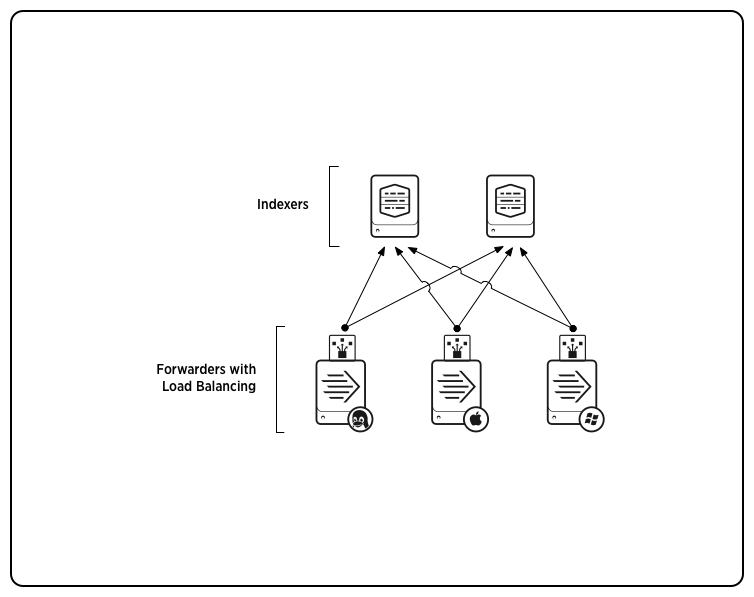
Routing and filtering
In data routing, a forwarder routes events to specific hosts, based on criteria such as source, source type, or patterns in the events themselves. Routing at the event level requires a heavy forwarder.
A forwarder can also filter and route events to specific queues, or discard them altogether by routing to the null queue.
Here, a heavy forwarder routes data to three indexers based on event patterns:
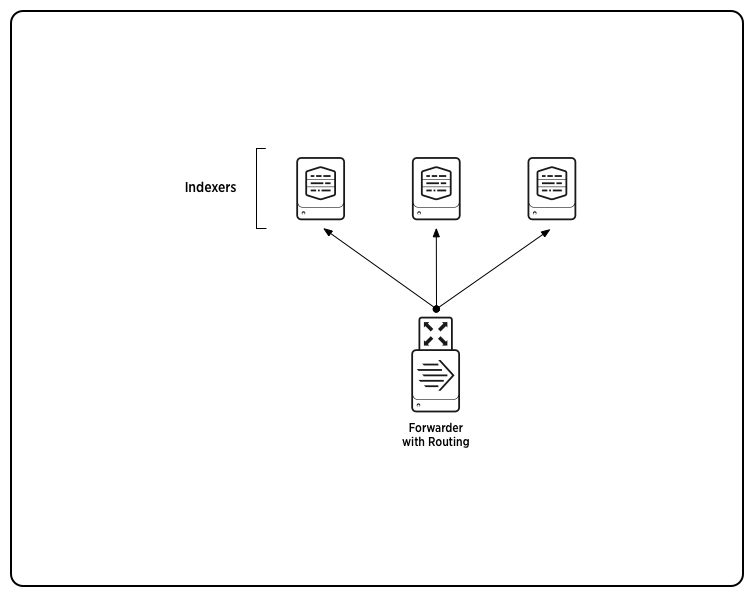
For more information on routing and filtering, see Route and filter data in this manual.
Forwarders and indexer clusters
You can use forwarders to send data to peer nodes in an indexer cluster. A Splunk best practice is to use load-balanced forwarders for that purpose.
This diagram shows two load-balanced forwarders sending data to a cluster:
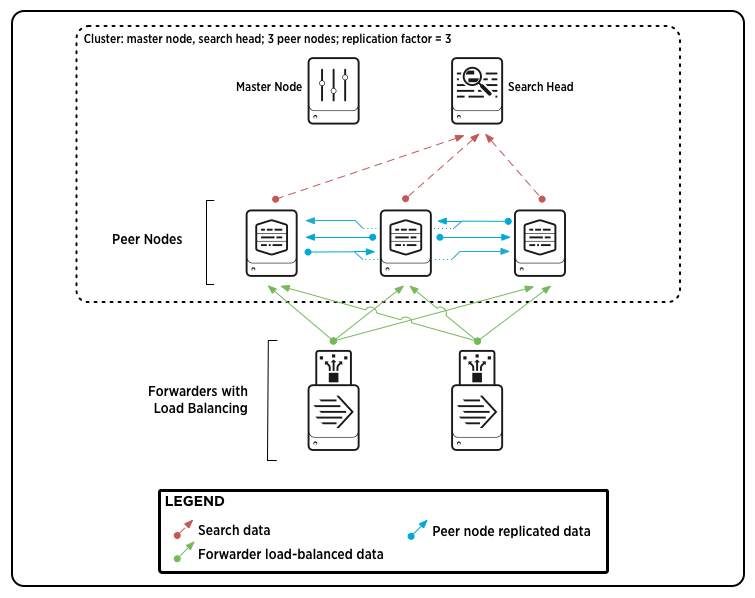
To learn more about forwarders and indexer clusters, see Use forwarders to get your data in Managing Indexers and Clusters of Indexers. To learn more about indexer clusters in general, see About indexer clusters and index replication.
Forward to non-Splunk systems
With a heavy forwarder, you can send raw data to a third-party system such as a syslog aggregator. You can combine this with data routing, sending some data to a non-Splunk system and other data to one or more Splunk instances.
In this diagram, three forwarders route data to two Splunk instances and a non-Splunk system:
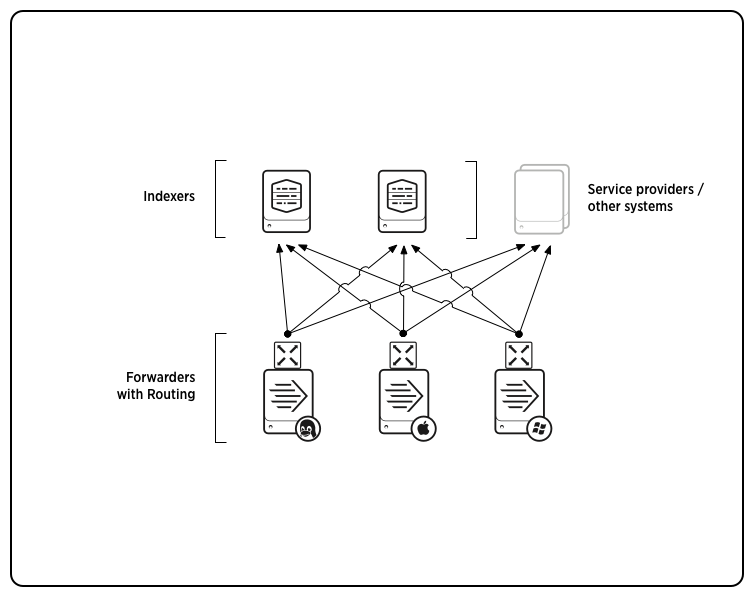
For more information on forwarding to non-Splunk systems, see Forward data to third-party systems.
Intermediate forwarding
To handle some advanced use cases, you might want to insert an intermediate forwarder between a group of forwarders and the indexer. In this type of scenario, the originating forwarders send data to a consolidating forwarder, which then forwards the data on to an indexer. In some cases, the intermediate forwarders also index the data.
Typical use cases are situations where you need an intermediate index, either for "store-and-forward" requirements or to enable localized searching. (In this case, you would need to use a heavy forwarder.) You can also use an intermediate forwarder if you have some need to limit access to the indexer machine; for instance, for security reasons.
To enable intermediate forwarding, see Configure an intermediate forwarder.
Scale your deployment with Splunk Enterprise components
In single-instance deployments, one instance of Splunk Enterprise handles all aspects of processing data, from input through indexing to search. A single-instance deployment can be useful for testing and evaluation purposes and might serve the needs of department-sized environments.
To support larger environments, however, where data originates on many machines and where many users need to search the data, you can scale your deployment by distributing Splunk Enterprise instances across multiple machines. When you do this, you configure the instances so that each instance performs a specialized task. For example, one or more instances might index the data, while another instance manages searches across the data.
This manual describes how to distribute Splunk Enterprise across multiple machines. Distributed deployment provides the ability to:
- Scale Splunk Enterprise functionality to handle the data needs for enterprises of any size and complexity.
- Access diverse or dispersed data sources.
- Achieve high availability and ensure disaster recovery with data replication and multisite deployment.
How Splunk Enterprise scales
Splunk Enterprise performs three key functions as it processes data:
1. It ingests data from files, the network, or other sources.
2. It parses and indexes the data.
3. It runs searches on the indexed data.
To scale your system, you can split this functionality across multiple specialized instances of Splunk Enterprise. These instances can range in number from just a few to many thousands, depending on the quantity of data that you are dealing with and other variables in your environment.
In a typical distributed deployment, each instance occupies one of three tiers that correspond to the key processing functions:
- Data input
- Indexing
- Search management
You might, for example, create a deployment with many instances that only ingest data, several other instances that index the data, and one instance that manages searches.
It is possible to combine some of these tiers or configure processing in other ways, but these three tiers are typical of most distributed deployments.
Splunk Enterprise components
Specialized instances of Splunk Enterprise are known collectively as components. With one exception, components are full Splunk Enterprise instances that have been configured to focus on one or more specific functions, such as indexing or search. The exception is the universal forwarder, which is a lightweight version of Splunk Enterprise with a separate executable.
There are several types of Splunk Enterprise components. They fall into two broad categories:
- Processing components. These components handle the data.
- Management components. These components support the activities of the processing components.
This topic discusses the processing components and their role in a Splunk Enterprise deployment. For information on the management components, see "Components that help to manage your deployment."
Types of processing components
There are three main types of processing components:
- Forwarders
- Indexers
- Search heads
Forwarders ingest data. There are a few types of forwarders, but the universal forwarder is the right choice for most purposes. It uses a lightweight version of Splunk Enterprise that simply inputs data, performs minimal processing on the data, and then forwards the data to an indexer. Because its resource needs are minimal, you can co-locate it on the machines that produce the data, such as web servers.
Indexers and search heads are built from Splunk Enterprise instances that you configure to perform the specialized function of indexing or search management, respectively. Each indexer and search head is a separate instance that usually resides on its own machine.
Processing components in action
This diagram provides a simple example of how the processing components can reside on the various processing tiers. It illustrates the type of deployment that might support the needs of a small enterprise.

根本在于分布式扩展index,search
Starting from the bottom, the diagram illustrates the three tiers of processing, in the context of a small enterprise deployment:
- Data input. Data enters the system through forwarders, which consume external data, perform a small amount of preprocessing on it, and then forward the data to the indexers. The forwarders are typically co-located on the machines that are generating data. Depending on your data sources, you could have hundreds of forwarders ingesting data.
- Indexing. Two or three indexers receive, index, and store incoming data from the forwarders. The indexers also search that data, in response to requests from the search head. The indexers reside on dedicated machines.
- Search management. A single search head performs the search management function. It handles search requests from users and distributes the requests across the set of indexers, which perform the actual searches on their local data. The search head then consolidates the results from all the indexers and serves them to the users. The search head provides the user with various tools, such as dashboards, to assist the search experience. The search head resides on a dedicated machine.
To scale your system, you add more components to each tier. For ease of management, or to meet high availability requirements, you can group components into indexer clusters or search head clusters. See "Use clusters for high availability and ease of management."
This manual describes how to scale a deployment to fit your exact needs, whether you are managing data for a single department or a global enterprise, or for anything in between.
splunk LB和scale(根本在于分布式扩展index,search)的更多相关文章
- cassandra mongodb选择——cassandra:分布式扩展好,写性能强,以及可以预料的查询;mongodb:非事务,支持复杂查询,但是不适合报表
Of course, like any technology MongoDB has its strengths and weaknesses. MongoDB is designed for OLT ...
- ElasticSearch Shard——本质上是做分布式扩展,副本对于集群的稳定性有很强的影响
什么是一个Shard? Shard就是一个Lucene Index,参照文章(深入理解Shard和Lucene Index). Index需要多少个Shard? 回答这个问题,我们需要先谈谈节点,一个 ...
- MySQL索引扩展(Index Extensions)学习总结
MySQL InnoDB的二级索引(Secondary Index)会自动补齐主键,将主键列追加到二级索引列后面.详细一点来说,InnoDB的二级索引(Secondary Index)除了存储索引列k ...
- AbpVnext使用分布式IDistributedCache Redis缓存(自定义扩展方法)
AbpVnext使用分布式IDistributedCache缓存from Redis(带自定义扩展方法) 我的依赖包的主要版本以及Redis依赖如下 1:添加依赖 <PackageReferen ...
- 从腾讯QQgame高性能服务器集群架构看“分而治之”与“自治”等分布式架构设计原则
转载:http://space.itpub.net/17007506/viewspace-616852 腾讯QQGame游戏同时在线的玩家数量极其庞大,为了方便组织玩家组队游戏,腾讯设置了大量游戏室( ...
- LB 高可扩展性集群(负载均衡集群)
一.什么是负载均衡 首先我们先介绍一下什么是负载均衡: 负载平衡(Load balancing)是一种计算机网络技术,用来在多个计算机(计算机集群).网络连接.CPU.磁盘驱动器或其他资源中分配负载, ...
- nginx反向代理、负载均衡以及分布式下的session保持
[前言]部署服务器用到了nginx,相比较于apache并发能力更强,优点也比其多得多.虽然我的项目可能用不到这么多性能,还是部署一个流行的服务器吧! 此篇博文主要学习nginx(ingine x)的 ...
- nginx+iis+redis+Task.MainForm构建分布式架构 之 (redis存储分布式共享的session及共享session运作流程)
本次要分享的是利用windows+nginx+iis+redis+Task.MainForm组建分布式架构,上一篇分享文章制作是在windows上使用的nginx,一般正式发布的时候是在linux来配 ...
- 高性能的分布式内存对象缓存系统Memcached
Memcached概述 什么是Memcached? 先看看下面几个概念: Memory:内存存储,不言而喻,速度快,对于内存的要求高,不指出的话所缓存的内容非持久化.对于CPU要求很低,所以常常采 ...
随机推荐
- 根据wsdl文件,Java工程自动生成webservice客户端调用
根据wsdl文件,Java工程自动生成webservice客户端调用 1,工具:带有webservice插件的myeclips 2,步骤: (1),新建一个Java工程:relationship (2 ...
- Django 将数据库查出的 QuerySet 对象转换为 json 字符串
通过Django查询出MySQL数据库的数据,并将查询出的QuerySet 对象转化成 json 字符串. 写这个例子的作用主要是用来为手机端提供接口用,记录一下,以后 说不准 肯定能用到! ---- ...
- 20145307陈俊达_安卓逆向分析_APKtools分析smail
20145307陈俊达_安卓逆向分析_APKtools分析smail 引言 真刺激呢!到了第二篇博客了,难度开始加大,之前是简单的dex2jar和有图形界面的jd-gui,现在来隆重介绍强大的反汇编工 ...
- HDU 1874 畅通工程续(最短路训练
因为数据比较小 所以flyod spfa dijkstra 多可以过 Floyd #include <bits/stdc++.h> using namespace std; const i ...
- 从nodejs到在线商城
nodejs安装express开发框架 (开发环境:mkdir nodeshop && cd nodeshop > npm init > npm install expre ...
- 【eclipse】阿里巴巴代码检测插件在线安装
https://p3c.alibaba.com/plugin/eclipse/update
- Spirng boot 启动的时候进行监控检查不通过停止服务与自定义健康监控节点
基于 spring-boot-starter-actuator • 前提条件: <dependency> <groupId>org.springframework.bo ...
- 【Python】【环境搭建】
[环境配置] Windows : http://blog.csdn.net/zhunianguo/article/details/53524792 [Pycharm] pyCharm最新2018激活码 ...
- tyvj 2075 [NOIP2012T5]借教室 区间更新+二分
描述 在大学期间,经常需要租借教室.大到院系举办活动,小到学习小组自习讨论,都需要向学校申请借教室.教室的大小功能不同,借教室人的身份不同,借教室的手续也不一样.面对海量租借教室的信息,我们自然希望编 ...
- PHP框架CI(codeigniter)的使用笔记
流程图: 控制: 1.当想在控制类中直接跳转到其它控制类时,可以使用redirect()函数. 2.session的应用,在分页查询的时候可以用session(普通的get方式对CI来说太麻烦了):在 ...
